10 Demographics of Individuals Prone to Dreaming of Childhood Rooms
Want a Personalized Dream Interpretation?
Curious about how people like you interpret this dream symbol? Explore personalized interpretations tailored to your demographic. Get personalized insights for free!
Get Free Interpretation Now →Table of Contents
1. Children and Adolescents
For children and adolescents, dreaming about their childhood room can evoke a range of emotions.
- Safety and Comfort: The familiar surroundings of their childhood room can represent a sense of security and belonging. It's a place where they feel safe and protected.
- Nostalgia: As they grow older, children and adolescents may miss the simplicity and innocence of their childhood. Dreaming about their childhood room can provide a comforting sense of nostalgia for this lost time.
- Growth and Change: Conversely, the childhood room can also symbolize the passage of time and the changes that come with growing up. The room may appear different or unfamiliar, reflecting the ways in which the dreamer has changed and matured.
- Unresolved Issues: Sometimes, childhood rooms in dreams can represent unresolved childhood issues or conflicts. The dreamer may be trying to process difficult experiences or emotions from their past.
2. Individuals with Childhood Trauma
Childhood Trauma and the Dream Symbol of Childhood Room
For individuals who have experienced childhood trauma, dreams of their childhood room can be particularly evocative and revealing. These dreams often symbolize a return to a safe haven, a place of both comfort and vulnerability.
The room itself may be unchanged from the dreamer's memory, or it may have undergone alterations that reflect their current state of mind. The objects within the room can offer clues to the dreamer's unresolved feelings and unresolved traumas.
For example, a room that is dark and cluttered may signify a feeling of being overwhelmed by emotions. A room that is empty or unfamiliar may indicate a sense of loss or disconnection.
The presence of certain people or objects in the room can also be significant. A parent who was abusive in real life may appear in the dream as a protector. A treasured toy from childhood may symbolize innocence and safety.
By interpreting the symbols in their dreams of their childhood room, individuals with childhood trauma can gain valuable insights into their unconscious mind and the ways in which their past experiences continue to shape their present.
3. Adults with Nostalgic Tendencies
For adults with nostalgic tendencies, dreams of their childhood room can evoke a profound sense of longing and reminiscence. These dreams often serve as a portal to a simpler, more carefree time, offering a glimpse into the familiar surroundings of their past.

Within these dreams, the childhood room becomes a repository of cherished memories and emotions. The familiar objects and décor transport the dreamer back in time, triggering a nostalgic yearning for the innocence and security of their younger years. The bed where they slept, the toys they cherished, and the books they read become symbols of comfort and safety.
The dream room may also symbolize a desire for escape from the complexities of adulthood. It represents a longing for a simpler life, where worries and responsibilities were replaced by youthful imagination and play. The dreamer may find themselves longing to return to the days when their biggest concern was which game to play or what story to read before bed.
However, these dreams can also carry a bittersweet undertone. While they offer a nostalgic escape, they also remind the dreamer of the passage of time and the inevitable loss of childhood. The empty crib or the toys left behind can serve as a poignant reminder of the fleeting nature of youth and the need to cherish the present moment.
4. People Experiencing Major Life Transitions
For those undergoing significant life transitions, dreams of childhood rooms can carry profound meanings. These dreams often evoke feelings of nostalgia and longing. They may represent a desire to return to a simpler, more carefree time in life. Alternatively, they can symbolize the need for security and stability during times of change. The specific details of the room can provide further insights. A messy or cluttered room may indicate feelings of chaos and disorganization in the dreamer's current life, while a clean and organized room may suggest a sense of order and control. The presence of certain objects or people in the room can also be significant. For instance, a beloved childhood toy may represent a longing for comfort and familiarity, while a parent figure may symbolize the need for guidance and support.
5. Individuals Seeking Inner Child Connection
For individuals embarking on a journey of inner child connection, the dream symbol of a childhood room holds profound significance. It represents a longing to revisit the innocence, safety, and playfulness of their younger years.
This dream symbol invites the dreamer to explore their childhood experiences, both positive and negative. It encourages them to embrace the childlike wonder, creativity, and resilience that they may have forgotten or repressed. By reconnecting with their inner child, they can access a wellspring of healing and self-discovery.
The specific details of the childhood room in the dream provide further insight into the dreamer's emotional state. A bright and vibrant room suggests a positive and carefree childhood, while a dark and gloomy room may indicate unaddressed emotional wounds. The presence of familiar objects, such as toys or books, can trigger memories and evoke nostalgic emotions.
Ultimately, the dream symbol of a childhood room serves as a reminder that the inner child is always present within us. By embracing this aspect of ourselves, we can cultivate greater self-compassion, creativity, and a renewed sense of wonder in our adult lives.
6. Artists and Creatives
Childhood Room: A Creative Playground
For artists and creatives, the dream symbol of a childhood room is particularly resonant. This room, often imbued with memories of play, imagination, and exploration, provides a fertile landscape for the subconscious to explore the sources of inspiration and creative expression.
The childhood room in dreams represents a safe and nurturing space where ideas and emotions can be explored without judgment. It is a place where the artist's inner child can roam freely, allowing for unfiltered expression and the generation of groundbreaking ideas.
The objects and activities within the childhood room can offer clues to the artist's current creative process. Toys, games, and crafting materials may symbolize the playful and experimental nature of artistic creation. The presence of friends or family members may suggest a need for collaboration or support. Windows and doors represent the potential for new perspectives and exploration.
By analyzing the details of the childhood room in their dreams, artists and creatives can gain insights into their current creative struggles and potential paths forward. It is a place where the past, present, and future of their artistry intersect, empowering them to harness the imaginative and playful spirit that fueled their childhood creations.
7. Seniors Reflecting on the Past
For seniors, dreaming of their childhood room can evoke a maelstrom of emotions, both tender and poignant. It's a nostalgic journey back to a time of innocence, play, and the shaping of their identities.
The objects in the room often hold profound significance, symbolizing cherished memories and relationships. Toys and games represent the joys of childhood, while furniture and décor embody the love and comfort of family. The colors and textures of the room can evoke a visceral connection to the past, triggering both joy and a sense of loss.
Dreams of childhood rooms can also reveal deeper psychological dynamics. For some, it represents a longing for the simplicity and security of the past. It can be a way of coping with the challenges of aging, or simply a source of comfort during times of transition.
The subconscious mind uses these dreams to reflect on the past, to make peace with it, and to draw strength from the experiences of childhood. For seniors, these dreams can be a valuable tool for self-discovery and emotional well-being.
8. Persons with Attachment Issues
For those with attachment issues, dreaming of their childhood room can be a profound experience. These dreams often symbolize a longing for safety, security, and stability that they may have lacked during their formative years.
The room itself can represent a place of comfort and familiarity, where they felt protected and loved. However, it can also be a reminder of the emotional neglect or trauma they may have experienced.
The objects within the room can also hold significant symbolism. For example, a bed may symbolize vulnerability and the need for protection, while a window might represent a desire for connection with the outside world.
The overall atmosphere of the dream can also be revealing. A warm and inviting room suggests that the person is seeking comfort and self-acceptance. Conversely, a cold and empty room can indicate feelings of isolation and loneliness.
By exploring the symbolism of their childhood room dreams, persons with attachment issues can gain valuable insights into their subconscious desires and the ways in which their past experiences continue to shape them.
9. Those Exploring Identity and Belonging
Childhood Room: A Symbol of Identity and Belonging for Those Exploring Theirselves
For those who are delving deep into their sense of self and place in the world, the childhood room often emerges in dreams as a powerful symbol. This room carries within it the essence of one's formative years, holding the echoes of childhood experiences and the aspirations that shaped their identity.
When the childhood room appears in a dream, it invites the dreamer to revisit their roots and grapple with the complexities of who they are. It's a space where the past and present intertwine, where forgotten memories resurface and longings for connection arise.
Through these dreams, individuals are encouraged to reflect on their childhood experiences. Were they nurtured and supported? Did they feel a sense of belonging and acceptance? Or were there challenges and obstacles that left emotional imprints? The answers lie within the symbolism of the room's contents, its ambiance, and the interactions experienced there.
Furthermore, the childhood room in dreams can also symbolize a longing for a sense of belonging, particularly among those who may feel adrift or disconnected. It's a reminder that our origins shape who we are and that embracing our past can help us find our place in the present.
10. People with Regression Dreams
Childhood Room: Regression Dreams
For those experiencing regression dreams, dreaming of their childhood room is an intriguing occurrence that reflects their subconscious yearning for a simpler, more secure time.
This symbol represents a retreat from the complexities and challenges of adulthood. It signifies a longing to escape current responsibilities and reconnect with the innocence and comfort of youth.
The childhood room in dreams evokes memories of safety, stability, and unconditional love. It becomes a sanctuary where regression dreamers can find respite from the stresses of their waking lives and indulge in the comfort of nostalgia.
Often, these dreams are sparked by current situations that trigger feelings of inadequacy or insecurity. They provide a temporary escape, allowing dreamers to process difficult emotions and seek solace in the familiar surroundings of their past.
Through the symbol of the childhood room, regression dreams offer a glimpse into the subconscious desires and vulnerabilities of those experiencing them. They serve as reminders of the importance of self-care, the power of nostalgia, and the enduring connection we have to our childhood experiences.
Back to interpretation of childhood room

